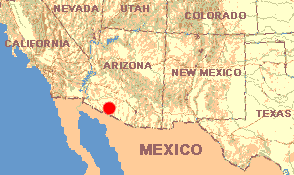 March 11, 1988
March 11, 1988ARIZONA: Pima County
In desert off AZ Hwy. 85 about ten miles SE of Ajo, just north of the entrance to Organ Pipe Cactus National Monument
 March 11, 1988
March 11, 1988During recent wildflower and bird walks, often I've caught glimpses of lizards and small mammals streaking away, but I've not identified a single one. Therefore, this morning I tune my radar for lizards and mammals, and head for the low, dark basaltic hills to the east.
At 9:00 AM, in a small outwash area strewed with large boulders and inhabited by widely spaced Creosote-bush, Ocotillo, Teddy Bear Cholla and Saguaro, I spook a cottontail. Though very similar to the Eastern Cottontails seen since Amistad, in subtle ways this individual is different. I'd never swear to it, but this cottontail seems to be smaller than what's average for Eastern Cottontails, its white tail may be more narrow and proportionally longer than I'm used to, and its ears seem larger.
In the Peterson field guide for mammals, reviewing the continent's various cottontail species, I find seven cottontail-like rabbits mentioned -- and that isn't counting jackrabbits, who posses very long hind legs and ears. According to the book's distribution maps, the only species found here is the Desert Cottontail, Sylvilagus auduboni. Now we're a little west of the Eastern cottontail's distribution. However, the Eastern cottontail's boundary is near enough to be worrisome if I want a definite identification. The field guide states that the Eastern cottontail is larger and has shorter ears than the Desert Cottontail, which supports my observation, but nothing is said about tail shape. Certainly this is Desert Cottontail habitat. Therefore, with 90% certainty, I'm saying that a desert cottontail just has been sighted.
Not five minutes later I spot a chipmunk-like critter holding perfectly still atop a basalt boulders. It's the old "if-I-don't-move-I'm-invisible trick." He looks a lot like the Whitetail Antelope Squirrel seen in Big Bend's Fresno Creek. However, the field guide's distribution maps show that though here we're almost surrounded by the Whitetail Antelope Squirrel's distribution area, we're not in it. However, we are within the distribution of the look-alike Yuma Antelope Squirrel, Ammospermophilus harrisii. One of my books calls the Yuma Antelope Squirrel the Harris Ground Squirrel.
By 10:00 it's become warm enough for lizards to start moving about. Right on cue I spot a five-incher still so cold that I'm able to draw very near. Disconcertingly, this individual doesn't resemble any of the pictures in my Audubon Society reptile-and-amphibian field guide. Consequently I sit down and list all of the species whose form and shape even vaguely suggests this one's. Of course I realize that many animals are differentiated into two or more subspecies, and the book can't illustrate them all. I list fifteen candidates. Then, referring to distribution maps and the book's descriptions of the various species's habitat preferences and behavior, I systematically eliminate... all fifteen possible candidates.
Starting over, I read each and every subspecies description. Eventually I find a written description of one of nine subspecies of Desert Spiny Lizard, Sceloporus magister, that fairly fits the individual still patiently sunbathing before me. Though my lizard is strongly striped and has no black splotch before its front shoulders, and the book's picture of this species shows an unstriped, heavily blotched lizard, the written description reveals that on young and females the spot is absent, and that the subspecies occurring in southwestern Arizona is striped. I'll say with 90% certainty, then, that here we have a Desert Spiny Lizard. Yeah, now that I'm noticing the blue dorsal flecks, the rough scales and the stubby tail, maybe I'm 95% sure...
By the time I've settled on "Desert Spiny Lizard," the sun is so high and it's so hot that lizards and mammals seem to have disappeared. Not until 3:00 PM, on the sandy bank of an arroyo, does a Western Whiptail, Cnemidophorus tigris, a lizard, come along. Gray-brown and with many dark spots more or less forming longitudinal bands along its sides and above, it matches very well the Audubon field guide's picture. As I watch, it digs in leaf-litter beneath a Creosote-bush, then walks across the disturbed area flicking the ground with its tongue. I see no insects there. What's it doing? This species is divided into about fifteen subspecies, six of which are found in the U. S.
At 3:30, in the sand of a broad, dry arroyo, I meet up with our old friend, the Zebra-tailed Lizard, Callisaurus draconoides. This was our first lizard, met on the Papago Indian Reservation near Sells. This species is divided into twelve subspecies, of which three are found in the U. S.
If I've given the impression that mammal- and lizard- watching are a little more tricky than bird- and wildflower- watching, maybe that's right!